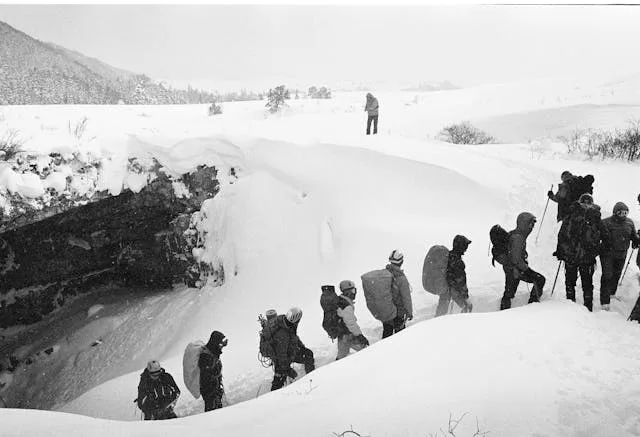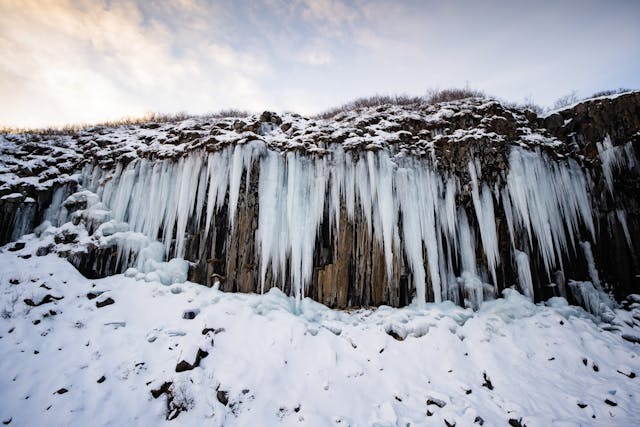Ice climbing is a thrilling winter adventure that combines the technical skills of rock climbing with the unpredictable beauty of frozen water. This exhilarating sport challenges climbers mentally and physically, offering a unique sense of accomplishment and stunning views from the world’s most spectacular ice formations.
Contents
 What is ice climbing?
What is ice climbing?
Ice climbing involves ascending frozen waterfalls, glaciers, or other ice formations using specialized gear like ice axes and crampons. Unlike rock climbing, where climbers grip onto the rock’s surface, ice climbers swing their axes into the ice and kick their crampons into the frozen formations to establish handholds and footholds.
 Types of Ice Climbing
Types of Ice Climbing
Waterfall Ice Climbing: The most popular form of ice climbing, involves ascending frozen waterfalls of varying grades and difficulties.
Alpine Ice Climbing: This type incorporates ice climbing as part of a larger mountaineering objective. Alpine ice climbers might navigate frozen couloirs, glaciers, and ice-covered faces.
Mixed Climbing: This advanced discipline blends ice climbing with traditional rock climbing techniques.
 Essential Gear for Ice Climbing
Essential Gear for Ice Climbing
Ice climbing requires a unique set of tools and equipment, including:
As you would expect, ice climbing requires some technical gear. You will need the proper equipment, both to shield you from chilly temperatures and to actually climb.
Ice Axes: specialized tools with picks designed for penetrating ice.
Crampons: spiked metal frames attached to boots to provide traction on ice.
Helmet: Protection for your head is essential in case of falling ice or a fall.
Harness: for attaching ropes and other safety equipment.
Ice Screws: protective devices screwed into the ice to create secure anchors.
Ropes: Used for belaying and rappelling.
Technical Clothing: warm, waterproof layers that allow for flexibility and movement.
 Getting Started with Ice Climbing
Getting Started with Ice Climbing
If you’re intrigued by the allure of ice climbing, these are the best ways to begin:
Hire a Guide or Instructor: Start by taking an introductory course or hiring a certified ice climbing guide. This is the safest and most efficient way to learn the basics.
Build Rock Climbing Skills: A solid foundation in rock climbing is helpful for developing the techniques you’ll need on the ice.
Practice, practice, practice: Ice climbing demands specific skills and techniques, so dedicate time to practicing your swing and footwork.
 Where to Go Ice Climbing
Where to Go Ice Climbing
Some of the world’s most famous ice-climbing destinations include:
Ouray Ice Park, Colorado, USA
Hyalite Canyon, Montana, USA
Canadian Rockies (Banff, Canmore), Canada
Cogne, Italy
Rjukan, Norway
 Is ice climbing dangerous?
Is ice climbing dangerous?
Like any adventure sport, ice climbing has inherent risks. It’s crucial to minimize these risks by following these steps:
Training and Education: Take courses and learn proper techniques.
Partner Up: Always climb with a reliable and experienced partner.
Weather and Conditions: Be aware of ice conditions and avalanche potential.
Proper Gear and Skills: Use the right equipment and confidently use it.
FAQ
Q: Do I need to be experienced in rock climbing to take up ice climbing?
A: While rock climbing experience will be beneficial, it’s not mandatory. With proper instruction and practice, motivated individuals can develop the skills needed for ice climbing.
Q: Where can I find beginner-friendly ice climbs?
A: Many ice climbing destinations offer routes suitable for beginners and guided tours. Instructor-led courses also take place in specific beginner locations.
Q: What’s the best time of year for ice climbing?
A: The ideal season depends on the location, but generally, December to March is the peak ice-climbing season in the northern hemisphere.
The Thrill of the Climb
Ice climbing is a sport of calculated risk, relentless determination, and breathtaking beauty. If you seek outdoor adventures that test your limits and reward you with otherworldly landscapes, ice climbing might be your next great passion.

 What is ice climbing?
What is ice climbing? Types of Ice Climbing
Types of Ice Climbing Essential Gear for Ice Climbing
Essential Gear for Ice Climbing Getting Started with Ice Climbing
Getting Started with Ice Climbing Where to Go Ice Climbing
Where to Go Ice Climbing Is ice climbing dangerous?
Is ice climbing dangerous?